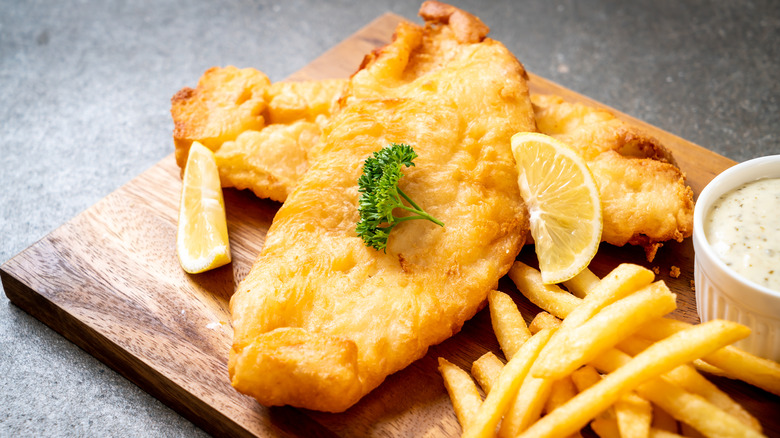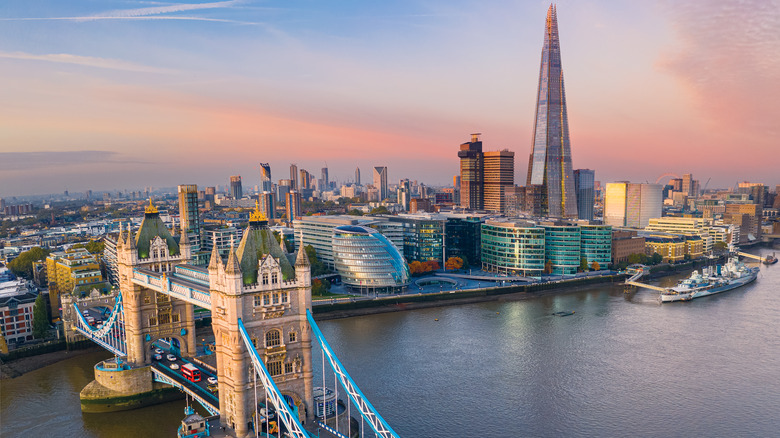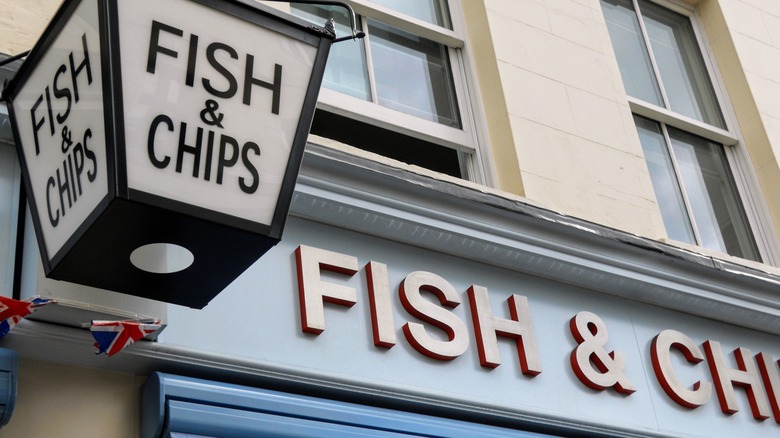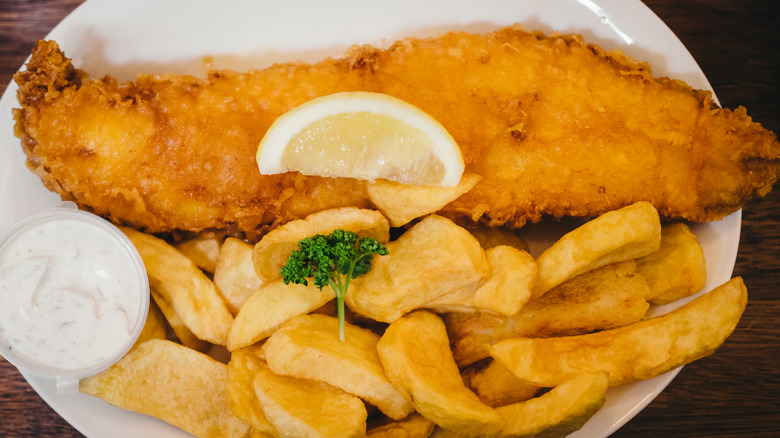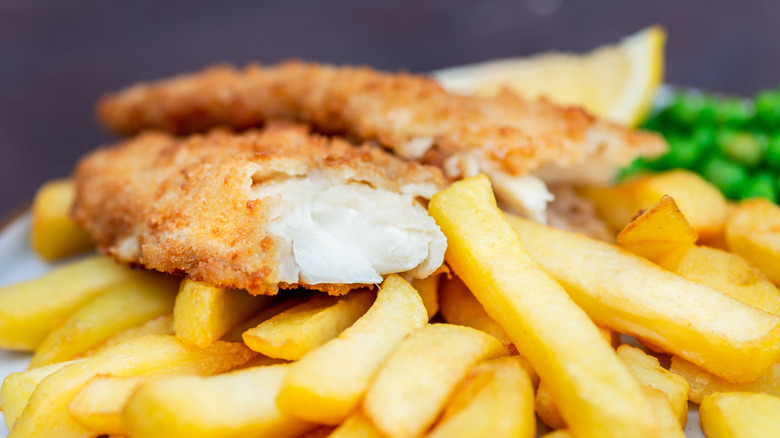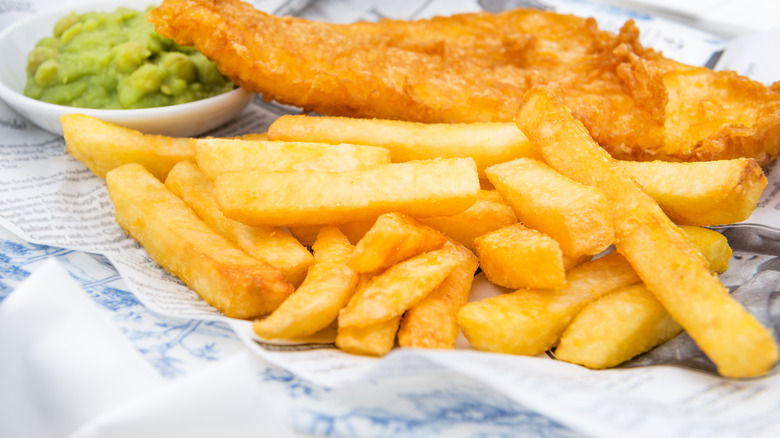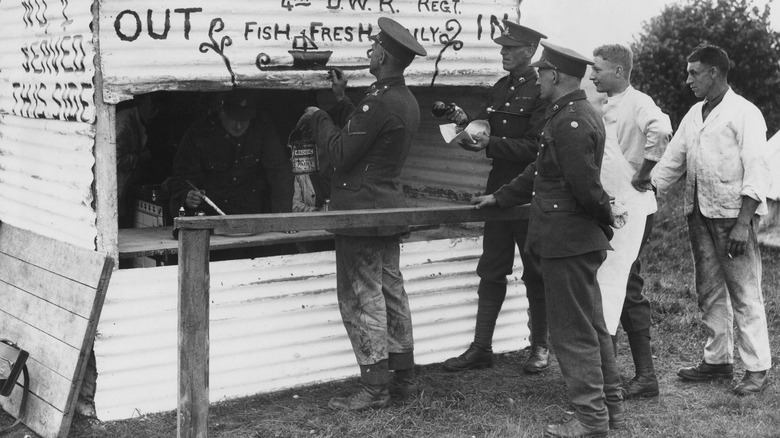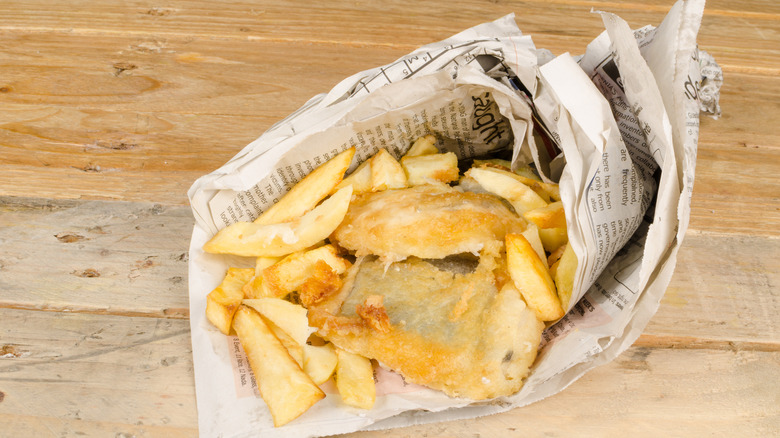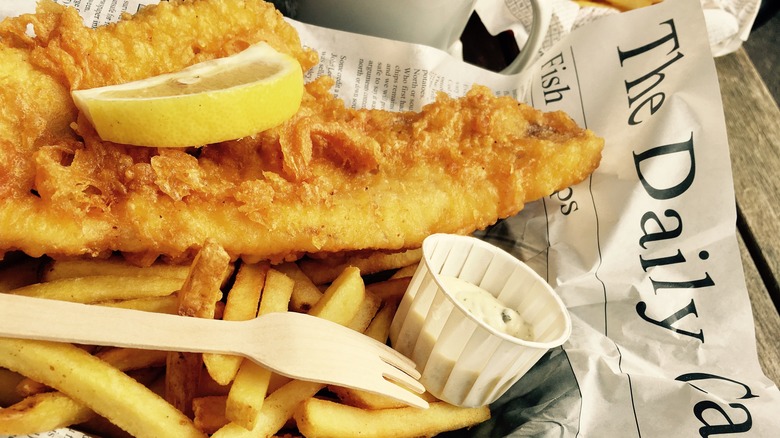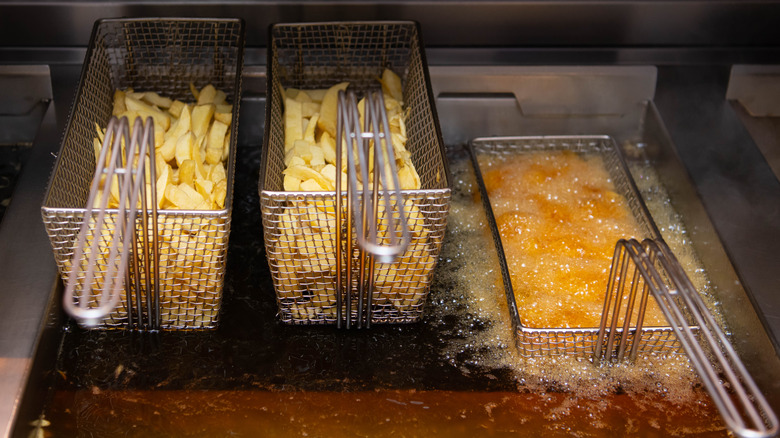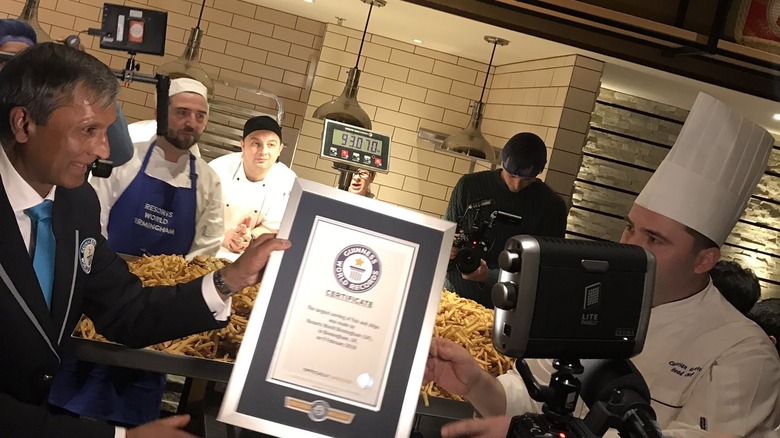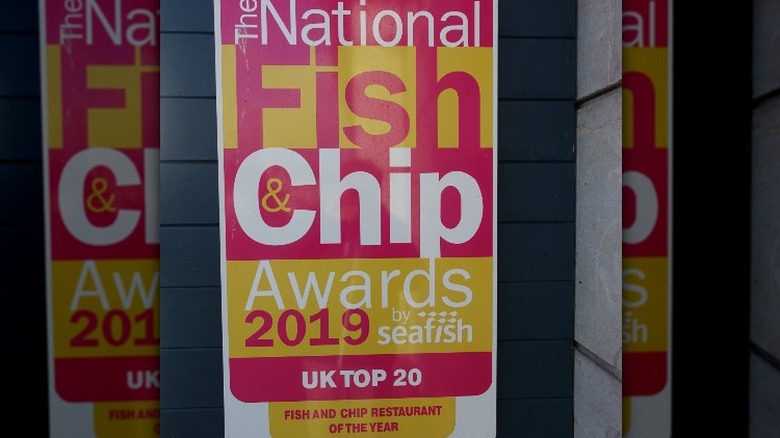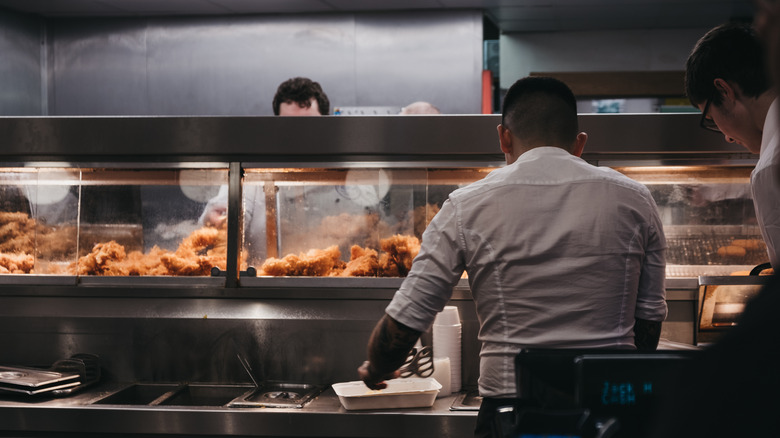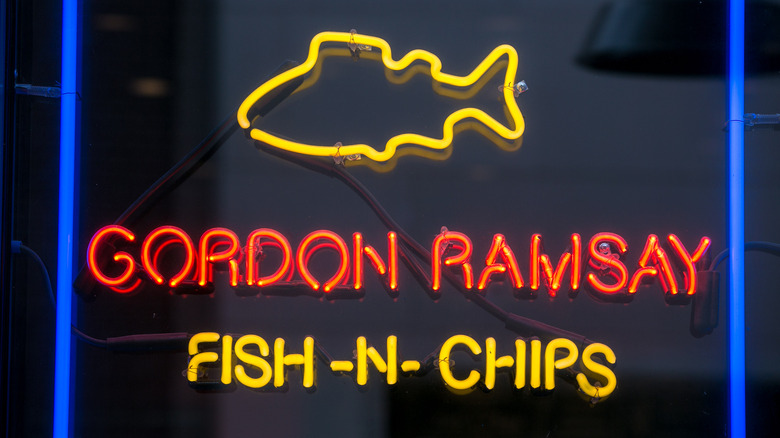The Untold Truth Of Fish And Chips
Ask anyone traveling to the United Kingdom for a vacation what they plan on eating while they're there, and you'll probably hear a mention or two of fish and chips. While fish and chips might not be a traditional American dish, most in the US are familiar with the concept, and everyone knows it as that popular favorite of our neighbors across the pond. Fried white fish served alongside french fries, topped with salt or malt vinegar, maybe with a side of mushy peas (depending on where you are), and finger-licking greasy, fish and chips is comfort food like no other.
However, just because fish and chips consists of one fried and greasy item paired with another hardly means it's a relatively modern result of the fast-food industry. Instead, fish and chips goes way back to the mid-19th century in — where else? — England. Here's the untold truth of fish and chips.
Two English cities lay claim to fish and chips
According to Historic U.K., there are two English spots that try to claim fish and chips as their own invention: Lancashire and London.
In Lancashire, a fish and chip shop opened in Mossley in approximately 1863, where a Mr. Lees ran a fish and chips stand in a market before switching to a brick-and-mortar location. Even at that first permanent location, Lees claimed that his location was the very first fish and chip shop in the entire world via signage plastered across the front window.
In London, however, a fish and chip shop opened in the 1860s — the exact year is vague — with Joseph Malin at the helm. This London shop gets an extra helping of credence, thanks to Malin's Jewish heritage. As we'll see, many credit Jewish refugee populations with making fried fish popular throughout the country.
Regardless of who opened the very first fish and chip shop in the world, though, we do know that many Londoners were eating fried fish as early as the 1830s, as the food is mentioned in Charles Dickens' England-set "Oliver Twist."
The Industrial Revolution fueled fish and chips
The First and Second Industrial Revolutions dating back to the 18th century resulted in a massive growth in London's working class. As more people moved away from home-based labor to working in factories and other employment outside the home, they needed a cheap and readily available meal to keep them going. For many, fish and chips filled that need.
As the BBC reports, potatoes were already a staple food source for London's impoverished masses, but new developments around the Second Industrial Revolution made the popularity of fish and chips possible. New fishing ships frequented the North Sea, catching the white fish needed for the dish. New refrigeration methods could ship those fish to the city in greater quantities on new steam railways. It's no wonder that by 1910, there were more than approximately 25,000 fish and chips restaurants in the United Kingdom. That number peaked in 1927 with more than 35,000 fish and chips-dedicated eateries.
London's oldest fish and chips stand
While London's claim to the advent of fish and chips rests on Joseph Malin's 1860s fish and chip shop, Malin's shop is no longer around today. Instead, the oldest, still-operational fish and chips stand in London is currently Rock and Sole Plaice, which originally opened in 1871 in Covent Garden. According to the restaurant's website, it might not have been the first fish and chips shop in London, but it was the third, which is pretty close. At the time, it served employees at nearby local markets, factories, and warehouses. After the Second Industrial Revolution, it continued to serve London through events of historical significance, such as during World War II when the shop hosted meetings on feeding homeless Londoners following German bombings.
Since the shop's founding, it's changed ownership several times, but now it welcomes quite a few tourists. The shop is even featured in more than 3,000 travel guides in more than 20 languages and appears in a range of television programs as one of the top spots to try historic fish and chips in London.
How did fried fish get to London?
Whether they were the first or the third shop, located in Lancashire or London, the concept of fried fish had to make its way to England before anyone could start selling fish and chips. For that, we have Spanish, Portuguese, and Jewish refugees to thank.
According to the International Rescue Committee in the U.K., fried fish similar to what became one-half of the fish and chips duo could be found in England as early as the 1500s. Under religious persecution, Jewish refugees fled from Spain and Portugal around that time, finding homes in England. There, they made their "pescado frito," or fried cod or haddock with a thin flour breading, cooked on Fridays, and eaten cold over the weekend.
Similarly, Joseph Malin's 1860s fish and chips shop has ties to refugee crises, as Malin was an Ashkenazi Jew who migrated from Eastern Europe in the 1800s during a time of extreme persecution.
What about the chips?
Whether you call them chips or French fries, the second half of fish and chips also got its start far before the Industrial Revolution. There are two potential groups who could have brought french fries to England, but both are groups of immigrants.
Some say French Huguenots, fleeing religious persecution in the 1600s, may have brought a very early version of french fries to London. Others, though, thank the Belgians. It's reported that 17th-century Belgian housewives would often fry potatoes rather than fish when rivers froze during the winter, making fishing unlikely. These fried potatoes became popular among the poor in general as Belgians moved to England. Who would've thought that those Belgian housewives who were frying potatoes to take the place of fried fish could've been laying the groundwork for fried potatoes to be served alongside fried fish centuries later?
Similar to the English, Americans got their taste for french fries from the Belgians, too — World War II soldiers discovered the fried food in Belgium and, since French was the dominant language in the region, they dubbed them "French fries" (via National Geographic).
Fish and chips boosted morale during the World Wars
The Americans weren't the only ones who loved those chips during wartime — the British really leaned into their love for this working-class meal during both World Wars.
During World War I, strong efforts were made to ensure Brits could still make their beloved fish and chips at home. This was in strong contrast to Germany, where German families often suffered from a lack of food supplies. Some say this helped keep British morale high, compared to low German morale, helping to win the war (per Fishers London).
Similarly, in World War II, the British never rationed the supplies needed for fish and chips, making it one of the few meals — and fish and chip shops one of the few businesses — unaffected by rations. As such, demand at fish and chip shops was high, with lines often stretching out the door. Additionally, during D-Day landings, British soldiers gave a fond nod to their patriotic dish, calling out "fish" and "chips" to one another as an identifier during the chaos.
What happened to wrapping fried fish in newspaper?
If you see any vintage photographs of some long-ago diner chowing down on fresh fish and chips, you'll likely notice those fish and chips are wrapped in a newspaper cone. In many instances, this was done to save money. Old newspapers were plentiful, so shop owners chose to reuse them as food receptacles. It was customary to wrap fish and chips in old newspapers until the 1980s, when laws were passed stating that food wrapped in newspaper must be separated from that newspaper by a grease-proof lining. This was to prevent the ink from spreading to the food. Nowadays, if you receive any food wrapped in newspaper, you'll likely notice upon closer inspection that the newspaper is really just food-safe wrapping with a newspaper-like print.
But what's the big deal? Is newspaper really dangerous? According to Food52, when reporting on 2017 food safety warnings issued in India, it's believed newspaper printing ink may contain cancer-causing ingredients, so it's best avoided, at least when it comes to dining.
Different ways of serving fish and chips
Depending on where you are in the United Kingdom, your fish and chips might be served differently with different condiments and/or sides. According to SeaFish data reported by Great British Magazine, pickled onions are the side of choice in Glasgow, while diners in Manchester enjoy gravy and mushy peas, and curry sauce is popular in Birmingham. However, most Brits do like their fish and chips served with salt, vinegar, and mushy peas.
As to where to eat that fish and chips with all its accompaniments? The preferred location is in the great outdoors, no matter where you happen to be in the United Kingdom. However, it's Belfast that probably can claim the greatest fondness for fish and chips overall. Belfast residents eat the most takeaway fish and chips in the United Kingdom, with 54% of Belfast survey respondents saying they eat takeaway fish and chips at least once per month.
Fish, potato, and oil differences
It's not just the sides and condiments that differ from place to place. Depending on where you are in the United Kingdom, you might also notice that the fish is different, as is the type of potato used and the type of frying oil.
As British Heritage points out, these ingredients often differ according to what was historically readily available in a certain region. In southern England, many fish and chip shops serve cod, sourced from the Barents Sea near Iceland and the Faroe Isles. In northern England, haddock — with its stronger flavor — is preferred, and Scottish diners also prefer haddock. Go over to Wales and you might see hake on your plate. Other white fish that come up on menus range from pollock to plaice and skate to sole.
Maris Piper potatoes are the most popular for fish and chips, as they're the most widely grown potato variety in the United Kingdom. However, if they're not available, other varieties that grow faster and earlier in the season might be used. The oil of choice is vegetable, but if you're going for historical accuracy, it's beef drippings all the way.
The biggest fish and chips in the world
In 2018, a British restaurant set the Guinness World Record for the world's largest serving of fish and chips. Resorts World Birmingham sourced and fried a 61.34-pound halibut and fried it for more than two hours to cook the fish through. The 61-pound fish was combined with another 60 pounds of chips in order to beat the previous world record (set by Fish and Chips @ LTD in London in 2012) by 16 pounds. Resort guests chowed down on the mammoth meal after the record was confirmed by a Guinness official.
However, that's not the only Guinness World Record that revolves around all things fish and chips. There's also a record for the fastest time to wrap five portions of chips. That record is held by Albany Fish Bar in Cardiff, Wales, where an employee wrapped five portions of chips in 48.17 seconds in 2017, beating the previous record of 50.08 seconds. Each portion of chips had to weigh a minimum of 12.35 ounces, be topped with salt and vinegar, and wrapped in at least two sheets of paper to qualify.
The National Fish & Chip Awards
It's not just Guinness World Records that are up for grabs. The National Fish & Chip Awards recognize the best fish and chips in the United Kingdom each year. The event is organized by SeaFish, a public organization that supports the United Kingdom's seafood industry. For more than 30 years, the awards have judged award entrants via a secret shopper-like method — judges go undercover to dine at shops and rank them by factors, such as food, sourcing practices, customer service, and even marketing. Beyond naming a fish and chip shop of the year, the awards also recognize the best newcomer and give honors for sustainability, menu innovation, and more.
While the awards were postponed for 2021 and 2022 due to the COVID-19 pandemic, the 2020 winners included The Cod's Scallops in Nottinghamshire, the Shap Chippy in Cumbria, and Fish & Chips at Weston Grove in Cheshire — all of which are worth adding to your itinerary the next time you find yourself across the pond.
Fish and chip shops in the U.K. today
As of 2014, there were more than 10,000 fish and chip shops in the United Kingdom — or about 10 times the number of McDonald's — and the shops accounted for about 10% of the nation's potato consumption and about 30% of its white fish consumption, according to Express. The £1.2 billion industry employs about 61,000 workers who dole out more than 380 million portions of fish and chips to hungry customers each year.
Unfortunately, the United Kingdom's fish and chips industry has not been immune to the COVID-19 pandemic, which has impacted restaurants around the globe. In 2020, industry publication IntraFish reported rising fish prices in Britain and restaurants being forced to change their business models to include contactless delivery and online ordering. Even in 2022, the worries are not over; in February 2022, ITV reported increasingly rising costs of ingredients since 2021, including a 75% increase in the cost of cod since 2021, 81% increase in the cost of haddock, 120% increase in the cost of mush peas, and 40% increase in the cost of fish batter.
Fish and chips in the US
Even though fish and chips is a staunchly British dish, you can still find some pretty great fish and chips in the United States. Mashed recently featured a list of the best fish and chips in America, only including those restaurants sticking to the English fish-and-chips criteria, as set by The Independent's chip shop competition. Those criteria include that the fish filets are boneless, not too oily, white, firm, and flaky, and that the fries or crisps are crispy on the outside and fluffy on the inside.
Restaurants that made the list aren't surprising. They include English-born options like Gordon Ramsay Fish & Chips, with its two stateside locations in Orlando and Las Vegas, as well as GB in Denver, which serves the city's surprisingly large community of British ex-pats. Of course, you've also got your array of seaside restaurants offering prime American seafood from the East Coast and New England to the Pacific Northwest.
Ready to get your fish and chips fix? Here's where to go without grabbing your passport.
